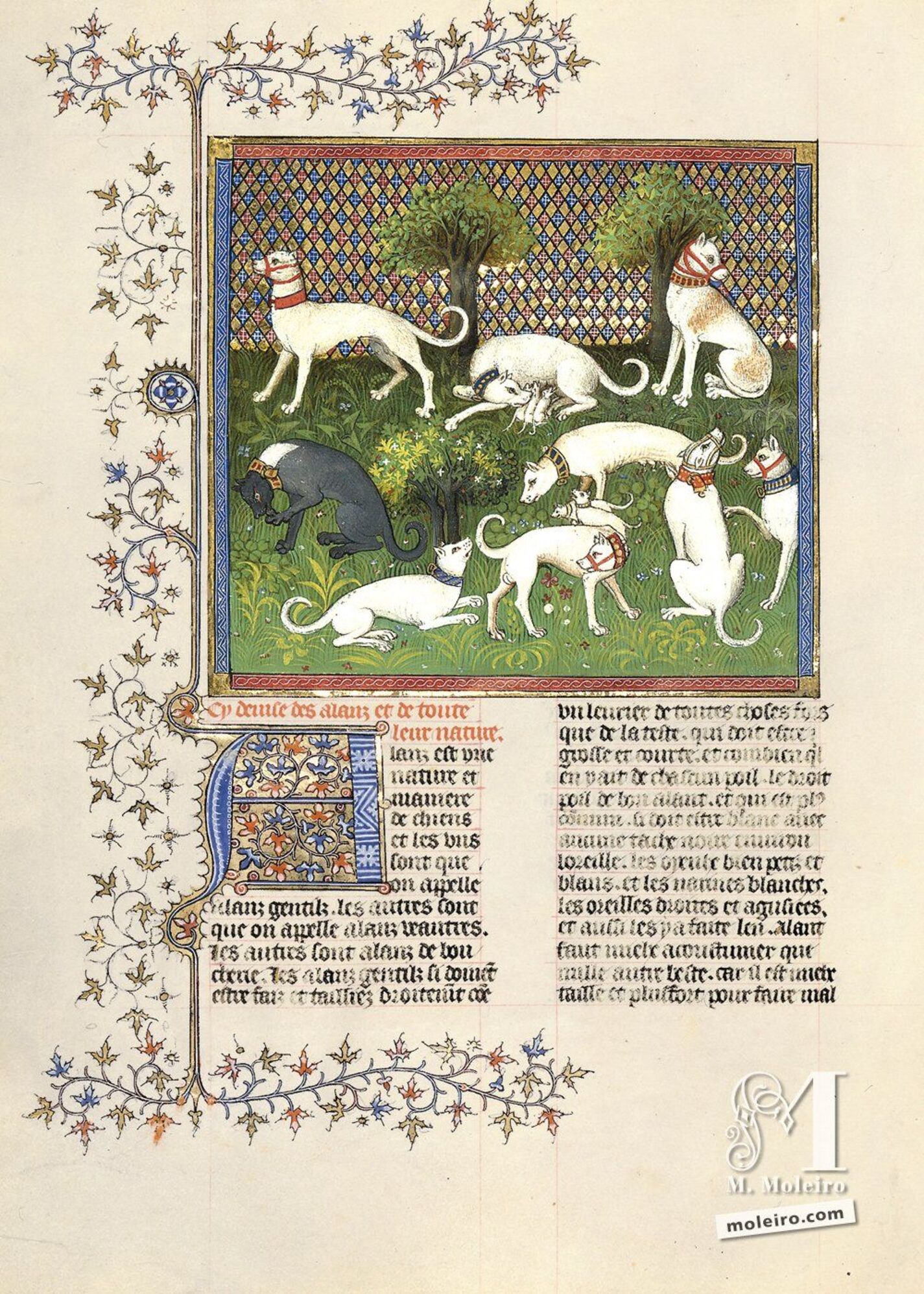The ´alaunt´, or mastiff, was not Fébus´ preferred breed of hound. He separates them into three types: alaunts gentle, alaunts veutreres, and the alaunts of the butchery. The gentles - or nobles - are strong and built like greyhounds, but with broad, short heads. Preferably, they are white. The black mark around their ears has not caught the attention of the miniaturist. By contrast, the mastiffs of the butchery are coarse dogs of a large build, which can be used to chase bears or wild boars, but always with other hounds. We say they are of the butchery because they often belong to people in this profession. Regarding the veutreres, they also look similar to greyhounds, but are larger and with long, hanging ears; they are useful for hunting larger animals. All these hounds are disobedient, even dangerous, and difficult to train. However, the rare dogs of this breed which can be successfully trained are the best that one can have. Due to the power of their jaw, they are able to hold fast an animal they have brought to the ground. Incidentally, these are the dogs – one of which has hanging ears – which have killed the wild boar in the December illustration of the Très riches heures du Duc de Berry. However, the scene (which shows nine hounds, including a mother nursing three whelps) only vaguely meets the precise descriptions given by the Count of Foix. All have short, pointed heads, but none have the veutreres´ long, hanging ears. All wear a solid collar, and five of them are well-muscled. The gentles, the veutreres and the coarser butchery hounds are impossible to distinguish from each other. The painter of the New York manuscript knew how to represent the hounds´ ugliness, which was so scorned by Fébus before he realised how necessary they were in a good pack; in contrast, our painter gives them a touch of elegance. As veutreres are above all used to hunt wild boars, we could therefore ask ourselves if the modern French term ´vautrait´ - which refers to groups which use hounds to hunt boar – could derive from the name of this hound.
Yves Christe,
Université de Genève

The ´alaunt´, or mastiff, was not Fébus´ preferred breed of hound. He separates them into three types: alaunts gentle, alaunts veutreres, and the alaunts of the butchery. The gentles - or nobles - are strong and built like greyhounds, but with broad, short heads. Preferably, they are white. The black mark around their ears has not caught the attention of the miniaturist. By contrast, the mastiffs of the butchery are coarse dogs of a large build, which can be used to chase bears or wild boars, but always with other hounds. We say they are of the butchery because they often belong to people in this profession. Regarding the veutreres, they also look similar to greyhounds, but are larger and with long, hanging ears; they are useful for hunting larger animals. All these hounds are disobedient, even dangerous, and difficult to train. However, the rare dogs of this breed which can be successfully trained are the best that one can have. Due to the power of their jaw, they are able to hold fast an animal they have brought to the ground. Incidentally, these are the dogs – one of which has hanging ears – which have killed the wild boar in the December illustration of the Très riches heures du Duc de Berry. However, the scene (which shows nine hounds, including a mother nursing three whelps) only vaguely meets the precise descriptions given by the Count of Foix. All have short, pointed heads, but none have the veutreres´ long, hanging ears. All wear a solid collar, and five of them are well-muscled. The gentles, the veutreres and the coarser butchery hounds are impossible to distinguish from each other. The painter of the New York manuscript knew how to represent the hounds´ ugliness, which was so scorned by Fébus before he realised how necessary they were in a good pack; in contrast, our painter gives them a touch of elegance. As veutreres are above all used to hunt wild boars, we could therefore ask ourselves if the modern French term ´vautrait´ - which refers to groups which use hounds to hunt boar – could derive from the name of this hound.
Yves Christe,
Université de Genève